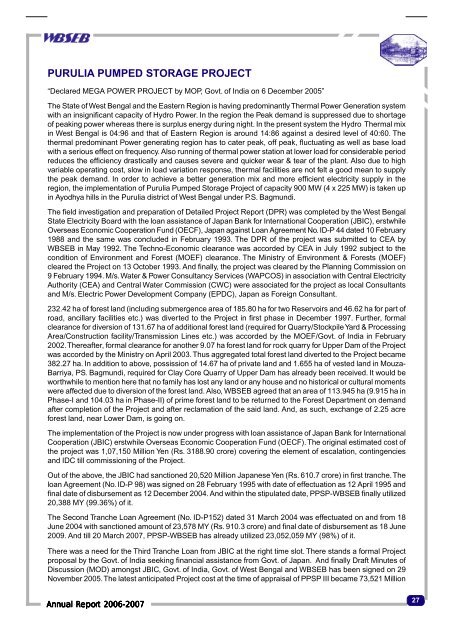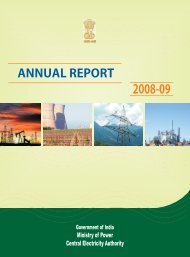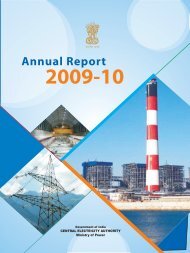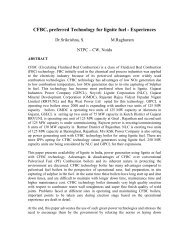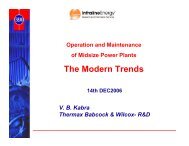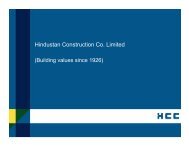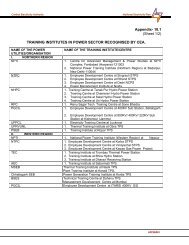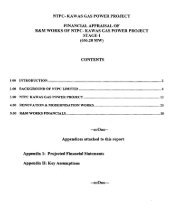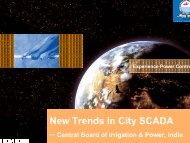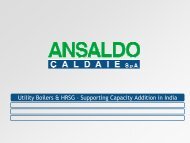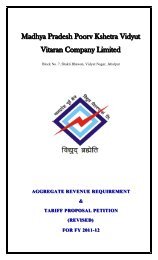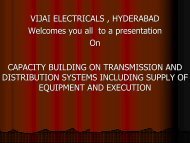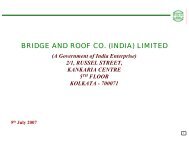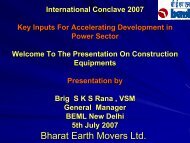Next part of the power scenario of the WBSEB comprises - Infraline
Next part of the power scenario of the WBSEB comprises - Infraline
Next part of the power scenario of the WBSEB comprises - Infraline
You also want an ePaper? Increase the reach of your titles
YUMPU automatically turns print PDFs into web optimized ePapers that Google loves.
PURULIA PUMPED STORAGE PROJECT<br />
“Declared MEGA POWER PROJECT by MOP, Govt. <strong>of</strong> India on 6 December 2005”<br />
The State <strong>of</strong> West Bengal and <strong>the</strong> Eastern Region is having predominantly Thermal Power Generation system<br />
with an insignificant capacity <strong>of</strong> Hydro Power. In <strong>the</strong> region <strong>the</strong> Peak demand is suppressed due to shortage<br />
<strong>of</strong> peaking <strong>power</strong> whereas <strong>the</strong>re is surplus energy during night. In <strong>the</strong> present system <strong>the</strong> Hydro Thermal mix<br />
in West Bengal is 04:96 and that <strong>of</strong> Eastern Region is around 14:86 against a desired level <strong>of</strong> 40:60. The<br />
<strong>the</strong>rmal predominant Power generating region has to cater peak, <strong>of</strong>f peak, fluctuating as well as base load<br />
with a serious effect on frequency. Also running <strong>of</strong> <strong>the</strong>rmal <strong>power</strong> station at lower load for considerable period<br />
reduces <strong>the</strong> efficiency drastically and causes severe and quicker wear & tear <strong>of</strong> <strong>the</strong> plant. Also due to high<br />
variable operating cost, slow in load variation response, <strong>the</strong>rmal facilities are not felt a good mean to supply<br />
<strong>the</strong> peak demand. In order to achieve a better generation mix and more efficient electricity supply in <strong>the</strong><br />
region, <strong>the</strong> implementation <strong>of</strong> Purulia Pumped Storage Project <strong>of</strong> capacity 900 MW (4 x 225 MW) is taken up<br />
in Ayodhya hills in <strong>the</strong> Purulia district <strong>of</strong> West Bengal under P.S. Bagmundi.<br />
The field investigation and preparation <strong>of</strong> Detailed Project Report (DPR) was completed by <strong>the</strong> West Bengal<br />
State Electricity Board with <strong>the</strong> loan assistance <strong>of</strong> Japan Bank for International Cooperation (JBIC), erstwhile<br />
Overseas Economic Cooperation Fund (OECF), Japan against Loan Agreement No. ID-P 44 dated 10 February<br />
1988 and <strong>the</strong> same was concluded in February 1993. The DPR <strong>of</strong> <strong>the</strong> project was submitted to CEA by<br />
<strong>WBSEB</strong> in May 1992. The Techno-Economic clearance was accorded by CEA in July 1992 subject to <strong>the</strong><br />
condition <strong>of</strong> Environment and Forest (MOEF) clearance. The Ministry <strong>of</strong> Environment & Forests (MOEF)<br />
cleared <strong>the</strong> Project on 13 October 1993. And finally, <strong>the</strong> project was cleared by <strong>the</strong> Planning Commission on<br />
9 February 1994. M/s. Water & Power Consultancy Services (WAPCOS) in association with Central Electricity<br />
Authority (CEA) and Central Water Commission (CWC) were associated for <strong>the</strong> project as local Consultants<br />
and M/s. Electric Power Development Company (EPDC), Japan as Foreign Consultant.<br />
232.42 ha <strong>of</strong> forest land (including submergence area <strong>of</strong> 185.80 ha for two Reservoirs and 46.62 ha for <strong>part</strong> <strong>of</strong><br />
road, ancillary facilities etc.) was diverted to <strong>the</strong> Project in first phase in December 1997. Fur<strong>the</strong>r, formal<br />
clearance for diversion <strong>of</strong> 131.67 ha <strong>of</strong> additional forest land (required for Quarry/Stockpile Yard & Processing<br />
Area/Construction facility/Transmission Lines etc.) was accorded by <strong>the</strong> MOEF/Govt. <strong>of</strong> India in February<br />
2002. Thereafter, formal clearance for ano<strong>the</strong>r 9.07 ha forest land for rock quarry for Upper Dam <strong>of</strong> <strong>the</strong> Project<br />
was accorded by <strong>the</strong> Ministry on April 2003. Thus aggregated total forest land diverted to <strong>the</strong> Project became<br />
382.27 ha. In addition to above, possission <strong>of</strong> 14.67 ha <strong>of</strong> private land and 1.655 ha <strong>of</strong> vested land in Mouza-<br />
Barriya, PS. Bagmundi, required for Clay Core Quarry <strong>of</strong> Upper Dam has already been received. It would be<br />
worthwhile to mention here that no family has lost any land or any house and no historical or cultural moments<br />
were affected due to diversion <strong>of</strong> <strong>the</strong> forest land. Also, <strong>WBSEB</strong> agreed that an area <strong>of</strong> 113.945 ha (9.915 ha in<br />
Phase-I and 104.03 ha in Phase-II) <strong>of</strong> prime forest land to be returned to <strong>the</strong> Forest De<strong>part</strong>ment on demand<br />
after completion <strong>of</strong> <strong>the</strong> Project and after reclamation <strong>of</strong> <strong>the</strong> said land. And, as such, exchange <strong>of</strong> 2.25 acre<br />
forest land, near Lower Dam, is going on.<br />
The implementation <strong>of</strong> <strong>the</strong> Project is now under progress with loan assistance <strong>of</strong> Japan Bank for International<br />
Cooperation (JBIC) erstwhile Overseas Economic Cooperation Fund (OECF). The original estimated cost <strong>of</strong><br />
<strong>the</strong> project was 1,07,150 Million Yen (Rs. 3188.90 crore) covering <strong>the</strong> element <strong>of</strong> escalation, contingencies<br />
and IDC till commissioning <strong>of</strong> <strong>the</strong> Project.<br />
Out <strong>of</strong> <strong>the</strong> above, <strong>the</strong> JBIC had sanctioned 20,520 Million Japanese Yen (Rs. 610.7 crore) in first tranche. The<br />
loan Agreement (No. ID-P 98) was signed on 28 February 1995 with date <strong>of</strong> effectuation as 12 April 1995 and<br />
final date <strong>of</strong> disbursement as 12 December 2004. And within <strong>the</strong> stipulated date, PPSP-<strong>WBSEB</strong> finally utilized<br />
20,388 MY (99.36%) <strong>of</strong> it.<br />
The Second Tranche Loan Agreement (No. ID-P152) dated 31 March 2004 was effectuated on and from 18<br />
June 2004 with sanctioned amount <strong>of</strong> 23,578 MY (Rs. 910.3 crore) and final date <strong>of</strong> disbursement as 18 June<br />
2009. And till 20 March 2007, PPSP-<strong>WBSEB</strong> has already utilized 23,052,059 MY (98%) <strong>of</strong> it.<br />
There was a need for <strong>the</strong> Third Tranche Loan from JBIC at <strong>the</strong> right time slot. There stands a formal Project<br />
proposal by <strong>the</strong> Govt. <strong>of</strong> India seeking financial assistance from Govt. <strong>of</strong> Japan. And finally Draft Minutes <strong>of</strong><br />
Discussion (MOD) amongst JBIC, Govt. <strong>of</strong> India, Govt. <strong>of</strong> West Bengal and <strong>WBSEB</strong> has been signed on 29<br />
November 2005. The latest anticipated Project cost at <strong>the</strong> time <strong>of</strong> appraisal <strong>of</strong> PPSP III became 73,521 Million<br />
Annual Report 2006-2007<br />
27


